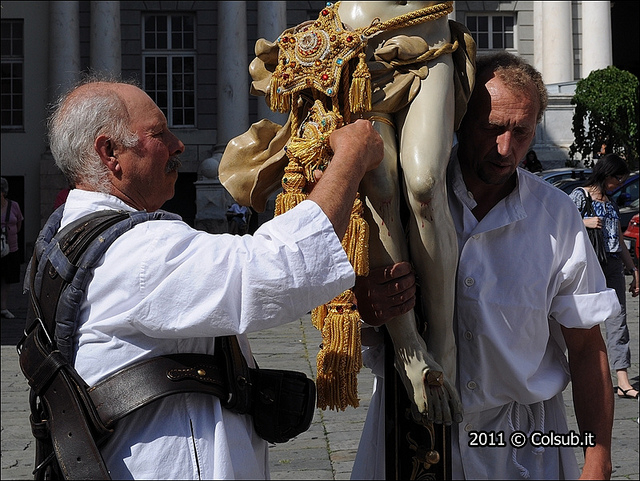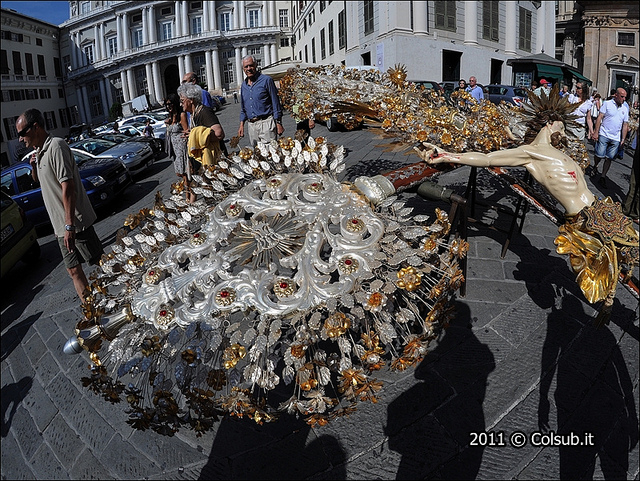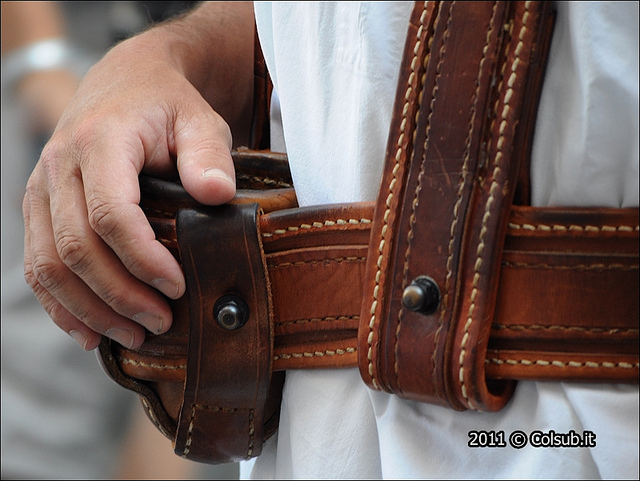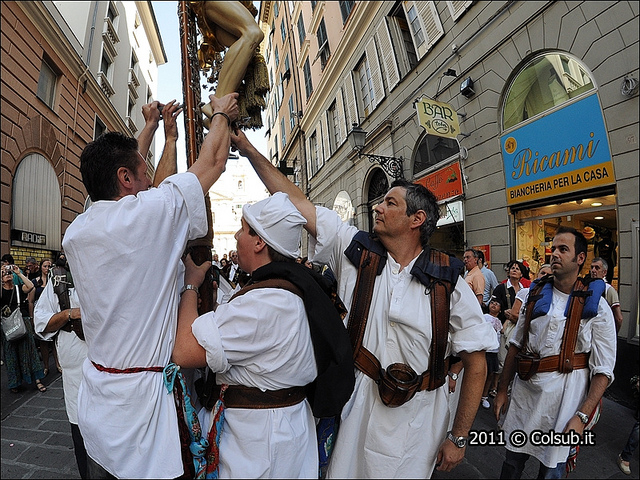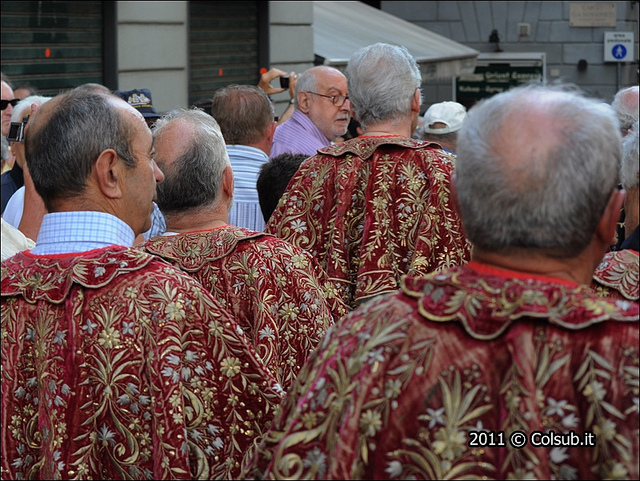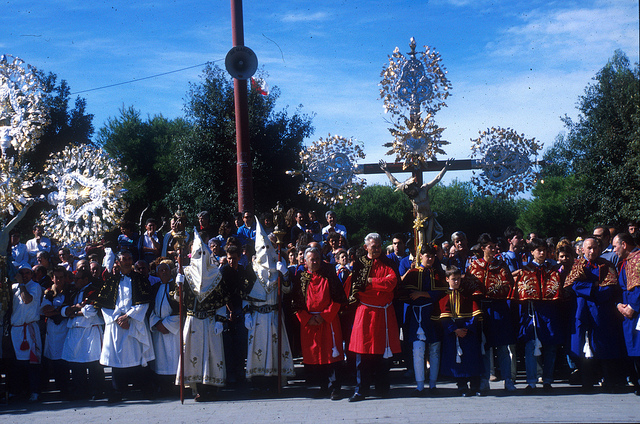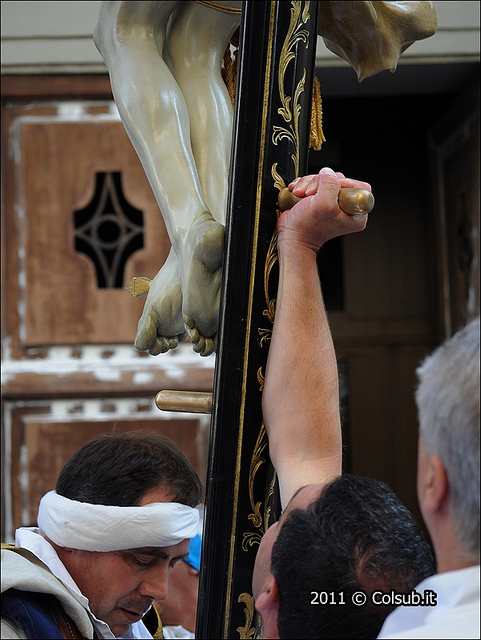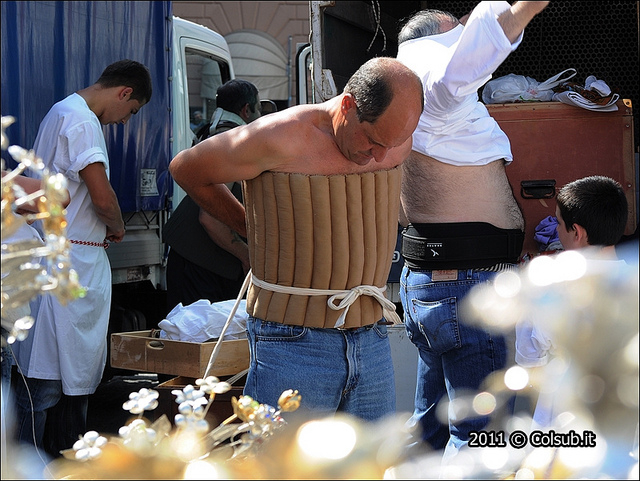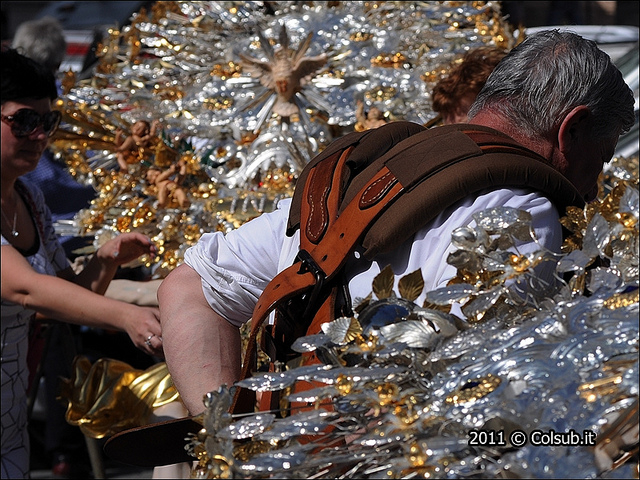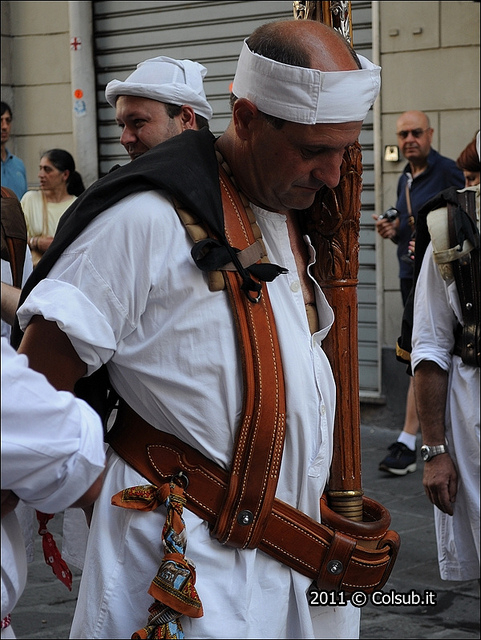Confraternities: a grand tradition with distant origins
Consisting of groups of people united by religion in secular associations for spiritual and charitable ends, the confraternities (from the Latin cum fratres, meaning "with brothers"), date right back to the early centuries of Christianity, taking on a more precise form in the Carolingian period and during the 10th century.
Depending on its size, each Confraternity had its own altar or chapel and at times even a church for their religious activities; the brothers met in their chosen location under the guidance of their Confraternity's "Prior" and a clergyman.
In general, the aim of the Confraternities was to promote various forms of worship (religious ceremonies, prayers, care and adornment of sacred places, processions, etc.), aiding sick brothers, organising funerals (not only for brothers but also for strangers of humble extraction), visiting prisoners, offering comfort to those condemned to death, collecting alms for special community needs, and providing wedding dowries for orphaned girls living in poverty.
The 8th century saw a huge rise in the number of "mendicant orders", with an increasing number of followers, riding the wave created by St. Francis of Assisi: these orders preached and practised the need to return to evangelical poverty and the use of forms of penance. In this context, in 1260, under the guidance of Raniero Fusani, the movement of the "disciplinanti" (also known as the "battuti" (beaten) or "flagellanti" (flagellants) formed in Perugia, soon spreading throughout Italy and giving rise to numerous Confraternities whose members committed themselves to practising forms of penance, such as abstinence and fasting, as well as forms of mortification of the flesh.
The name "flagellants" derives from flagellation, just as "beaten" derives from beatings, which the brothers inflicted upon themselves to remember the Passion of Christ, through their own flesh and by shedding their own blood.
During the Christmas of 1260, Sinibaldo degli Opizzoni, rector of the people of Tortona who had joined the movement of the "brothers of penance", brought a large number of "disciplinanti" to Genoa, inspiring initially curiosity, then wonder, then deep emotion and even active participation.
With the passage of time, the disciplinanti became more moderate in their behaviour and dress, and confraternities began to be named after Saints connected to the cities with which they had economic ties. The brothers often belonged to the same social class or practised the same profession; for this reason, the confraternities began to assume the role of "Guilds", providing a social support system.
Between 1480 and 1582, as many as 134 confraternities existed in Genoa; from 1587 onwards, the Archbishop of Genoa, Antonio Sauli, called upon the city's confraternities to follow the rules set forth by the Council of Trent (1545 - 1563).
Following the orders of the Council, large processional statues became widespread, many of them crafted by important artists such as A. M. Maragliano, a famous sculptor who created wonderful Genoese Baroque nativity scene figures in his workshop. These processional statues often featured one or more life-size figures depicting scenes from the Passion or miraculous events involving a confraternity's patron saint or the saint its main Oratory (or "Casaccia") was named after.
Beginning at the end of the 18th century, the confraternities became involved in the historical, political and socio-economic upheaval that besieged the city. Napoleonic laws led to the progressive dispersion of the magnificent heritage made up of the Oratories and their furniture, paintings and processional objects.
The tradition did not fall into oblivion, however, finding new areas of expression and gathering fresh momentum.
There are now 180 confraternities operating under the jurisdiction of the Archdiocese of Genoa. It is estimated that they take part in a total of 200 processions each year, between the spring and November.
The processions of the Casacce remain an eagerly awaited event.
On the evening of Maundy Thursday, the procession of the brothers, illuminated by the candles of those taking part, stops at the seven oldest churches of the medieval city to visit the famous tombs.
On June 24, the Feast Day of Saint John the Baptist, the entire afternoon is enlivened by a magnificent procession from the Cathedral to the Old Port, in which the historic confraternities participate, dressed in magnificent costumes and carrying large Baroque Crucifixes.
Over the summer, every week from the Feast of the Assumption (August 15) until mid-September, traditional Sunday pilgrimages are made by the western confraternities to the sanctuary of Nostra Signora dell'Acquasanta. The brothers climb on foot to the sanctuary, relying on the strength of their arms alone to carry their majestic, heavy Baroque crosses and artistic processional statues, even up the famous "Holy Stair".
On August 29, the confraternities make a pilgrimage to the Sanctuary of Nostra Signora della Guardia for the famous feast dedicated to the Madonna, protectress of the city of Genoa.
The Cristi, the Genoese dialect name for the large crucifixes carried in procession, with golden finials adorning the end of each arm, weigh over one hundred kilos each, with some weighing as much as 120 or even 160 kilos. The most valuable Cristi, however, dating to the 15th century, remain in the Oratories.
Of the over 500 Cristi belonging to Genoa's confraternities, many are the work of the Rungoldier family, a dynasty of sculptors from Trento that specialised in the art; others include those made by A. M. Maragliano, and the famous Black Christ sculpted by Bissoni in 1610 out of jujube wood.
The "bursting bundles" of the finials – featuring flowers and bells in silver leaf, or in gold or silver filigree – are placed at the ends of the arms of the cross.
A globe with rays radiating out from it is placed on Christ's head, and a golden fabric bow is tied at his side.
Processional statues are carried in the bearers’ arms or on their shoulders. The Capocassa (confraternity leader) marks time with a hammer: one beat is the signal to stop, two beats to change bearers (who may pass the statues directly from one to another, or stop and rest the statue on the ground).
At Acquasanta, when the bearers reach the top of the Holy Stair, fireworks are traditionally set off to welcome them, and the bearers greet the church and the faithful by raising their statue into the air once or twice.
The Portoei are bearers who carry the Cross without ever touching it with their hands.
The Stramuoei are the brothers responsible for passing the Cross from one bearer to the next, helping them to take turns; the Stramuoei grasp the mantinente (a horizontal handle on the side of the Cross) and hoist it up to insert it instantly into the cuppin of another carrier.
The brothers wear vestments known as cappe whose colours identify the confraternity they belong to.
Stretching down to the ground, and in the past with an opening on the back to leave the skin exposed for flagellations, they are now made of fabric, as opposed to the original sackcloth, and are narrowed in at the sides a cingolo, or girdle. The bearers of the Cristi also wear straps, protective bands and a leather belt sporting the crocco (holder) that supports the shaft of the cross; on the front of the crocco is a cuppin (a cup-shaped support) into which the pessin, the foot of the cross's vertical post, is inserted.
To protect their shoulders, the brothers wear a tabarro over their vestments: this embroidered velvet cape identifies the roles they play in their confraternity. On their heads, they wear a cap called a Boffa that once also covered their faces, with two holes cut out for the eyes.

